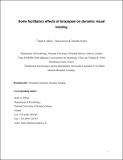| dc.contributor.author | Elliott, Mark | en |
| dc.date.accessioned | 2011-01-28T13:23:00Z | en |
| dc.date.available | 2011-01-28T13:23:00Z | en |
| dc.date.issued | 2006 | en |
| dc.identifier.citation | Elliott, M., Giersch, A., & Seifert, D. (2006). Some facilitatory effects of lorazepam on dynamic visual binding. Psychopharmacology, 184(2), 229-238. | en |
| dc.identifier.issn | 0264-3294 | en |
| dc.identifier.uri | http://hdl.handle.net/10379/1575 | en |
| dc.description.abstract | Rationale: The benzodiazepine lorazepam enhances the potential for inhibitory (GABAA) synapses in the cortex to stabilize postsynaptic, excitatory activity by synchronizing discharge rates at frequencies of around 40 Hz. Treatment with lorazepam also affects contour integration processes, suggesting that GABAA-mediated synchronization plays a role in visuospatial organization. This conclusion is supported by other physiological studies that link visual feature integration with neuronal synchronization.
Objectives: One experiment was conducted to assess variations in dynamic figural priming as a result of lorazepam administration.
Methods: Observers were presented a modified version of a figural priming paradigm designed to investigate the effects of dynamic synchronization on visual feature integration. The priming paradigm consisted of premask crosses presented in a square arrangement within the same phase of a multiphase premask matrix oscillating at 40 Hz. Observers responded to a subsequently presented target square. The modification consisted of line elements presented at various distances relative to the unspecified extension of the lines making up the premask crosses. It was expected that priming effects would be enhanced for lines terminating close to the unspecified extension but only following administration of lorazepam.
Results: As anticipated, priming was enhanced substantially when the premask crosses flickered around static lines that terminated adjacent to the unspecified extension between the premask crosses. This effect was maximal following treatment with lorazepam.
Conclusions: This finding supports the idea that GABAA-enhanced inhibitory synchronization mediates continuity coding during early visual processing. | en |
| dc.format | application/pdf | en |
| dc.language.iso | en | en |
| dc.publisher | Springer | en |
| dc.rights | Attribution-NonCommercial-NoDerivs 3.0 Ireland | |
| dc.rights.uri | https://creativecommons.org/licenses/by-nc-nd/3.0/ie/ | |
| dc.subject | Psychology | en |
| dc.subject | Lorazepam | en |
| dc.subject | Diazepam | en |
| dc.subject | Benzodiazepine | en |
| dc.subject | Visual binding | en |
| dc.subject | Synchronization | en |
| dc.subject | Temporal factors | en |
| dc.title | Some facilitatory effects of lorazepam on dynamic visual binding | en |
| dc.type | Article | en |
| dc.local.publishedsource | http://dx.doi.org/10.1007/s00213-005-0242-x | en |
| dc.description.peer-reviewed | peer-reviewed | en |
| dc.contributor.funder | University Hospital of Strasbourg | en |
| dc.contributor.funder | Deutsche Forschungsgemeinschaft project grant # EL 248/1-1 | en |
| nui.item.downloads | 567 | |


